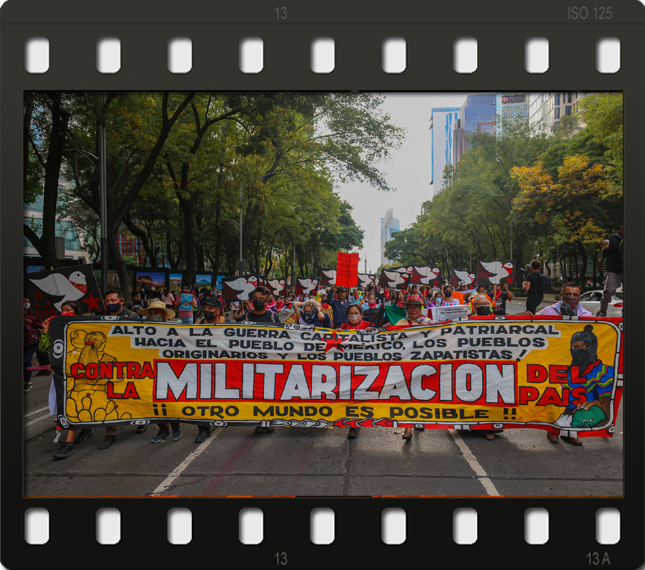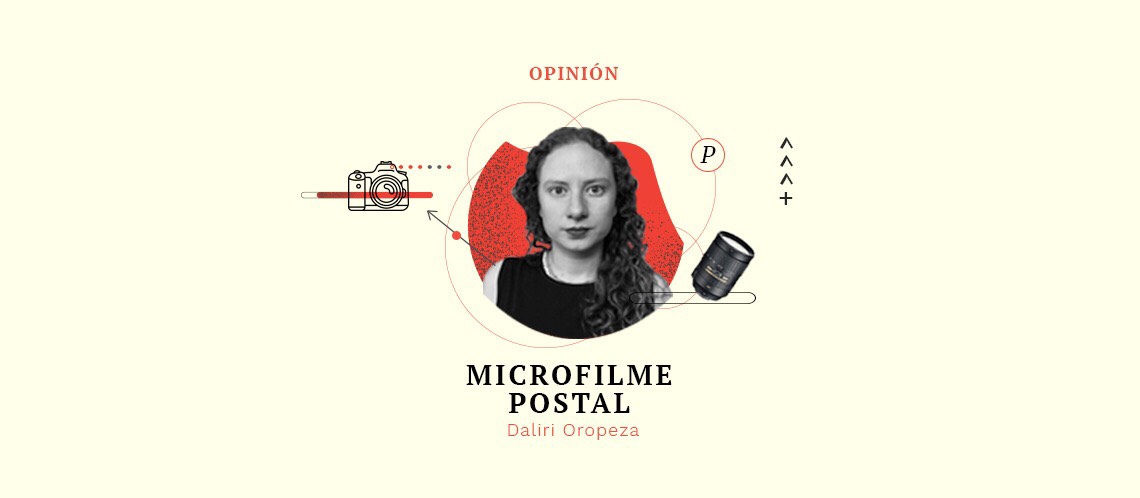There is a history of militarization of indigenous peoples in resistance to national megaprojects that is assuming certain peculiarities in this presidency.
By Daliri Oropeza Alvarez

The look of those who carry the banner is profound. They advance in full march. The message is clear: “Against the Militarization of the Country.” “Another World is Possible.” “Stop the Capitalist and Patriarchal War against the People of Mexico, Indigenous Peoples and the Zapatistas.”
The look of those who carry the banner is profound. They advance in full march. The message is clear: “Against the Militarization of the Country.” “Another World is Possible.” “Stop the Capitalist and Patriarchal War against the People of Mexico, Indigenous Peoples and the Zapatistas.”
Marichuy (María de Jesús Patricio Martínez) stands out with the banner in her hand, she is a Nahua spokesperson and member of the National Indigenous Congress. Delegates from the southeast also march, one of the regions where the CNI has diagnosed a growing problem with the increase in members of the Army that carry out joint megaprojects such as the Maya Train, the Interoceanic Corridor and the Morelos Integral Project.
The presence of the army and the militarization of indigenous peoples are nothing new in the history of the Mexican State. There are regions where their presence is normalized, both as security, as well as in the daily life of the people.
So, we see the army building airports or railroads, while they train some others to be members of the National Guard (GN) and for that they build barracks everywhere, without consulting the inhabitants.
Militarization in Mexico, according to the UNHCHR, is understood as “the deployment of the Armed Forces in cities and rural areas to exercise public security functions and “combat” organized crime, as well as other situations that they consider a threat.”
“The validity of a military paradigm in public security, which may include, in addition to the use of military forces in civic security tasks: the designation of active, licensed or retired military in public positions related to security, migration, prisons, law enforcement and other civil activities; the emulation of practices of a military nature within bodies classified as civilian, the weakening of the participation of civil authorities and citizens in security issues; the priority of the use of force in security situations over longer-term alternatives”, said Guillermo Fernandez-Maldonado, UNHCHR representative in Mexico.
What we see in Mexico now is another expression of the growing militarization that had already occupied public security tasks, now takes on construction and protection tasks for the main six-year term of office, trans-presidential and, geopolitically speaking, projects anchored to international commercial interests and based on the logic of the petrol. Without forgetting that the GN is also dedicated to work to contain migration.
The expansion of the Army’s work in sectors of the economy and supposed development make me think that there are countries where they are even owners of companies. Very powerful.
Disappearances and Organized Crime in Maya territory
Ángel Sulub is participating in the march against militarization. In an interview, he tells how, despite the fact that in 1901 the end of the Caste War of the Yucatán, in which his great-grandfather participated, against the rebel Mayas of Chan Santa Cruz (Noj Kaj Santa Cruz Xbaalam Naj) was decreed. The oral history of the ancestors tells that they never saw the end of that war. A battalion remained to see that they did not rise up again for their autonomous government.
“You have to remember that the grandfathers and grandmothers did not consider themselves Mexican, but they considered Mexico as an invader that was coming to dispossess them of their territory. The grandfathers and grandmothers lived in freedom”, affirms Angel.
In the talk he recalls that it was the Mayas who lived in freedom, and not slavery as in the henequen haciendas, who stood up for their autonomy. The route of the Maya Train project passes through those lands that their ancestors cared for, now named Felipe Carrillo Puerto in Quintana Roo.
“The defense of freedom is symbolically against those of the armies. These invading armies, those armies that came to plunder. When the Mexican Army enters this community. Take this town, which was a sacred town, which preserved all the essence of the Maya peoples, their spirituality, all their practices, well, ancestral, eh? It enters and takes this community under the command of General Ignacio A. Bravo, under the command of Porfirio Diaz. Then a very serious situation begins to be experienced with the presence and military control and a very cruel phase is experienced, a very serious phase of genocide of our people. The hunt of the Maya peoples begins.”
He assures that this genocide was not for racial reasons but for political ideals, which makes it unique, and with it came a stage of forgetting and erasing the abuses of the army from memory. For this reason, he is preparing a document with the U kuuchil k Ch’i’ibalo’on Center, since the most recent thing they have experienced is the increase in militarization to build the train and the accompanying industrial, tourist, and urbanization projects.
Now they see vehicles of both the Army and the National Guard patrolling every so often, a matter of a year since they are seen daily. “It’s part of the landscape.” With the presence of members of the military, disappearances, dismemberments, murders, executions, and the increase and visibility of criminal activities also arrived. All this is new for the Maya inhabitants of Carrillo Puerto.
“We see that this dispossession of memory has worked a lot, because when we look at how the military presence has increased at this time on the beaches, in public spaces in the communities, how the military are present even in activities where there are children, participating armed in school support brigades to paint or cut hair. In different ways, it is becoming very present, we know that it is a strategy to bring the army into the communities.”
And Angel knows that it will get worse, as they saw with his ancestors. He gives an account of the community diagnosis of it:
“Very heavy, that with the increase of the National Guard army, of the military in the territory, because what we are also seeing is an increase in crime, insecurity and fear”, he says with a sort of uncertainty and sadness for what they are experiencing.
Carlos Gonzalez, agrarian lawyer and member of the CNI, warns that “Militarization in the towns is growing, at least since the government of Felipe Calderon; however, the particular situation that we see today, which is the extent to which it is worsening in the processes of dispossession and destruction of the territories of indigenous peoples, along with the territorial expansion and economic and political influence of criminal cartels, it goes hand in hand with militarization. We see this increase in the processes of dispossession from very specific infrastructure megaprojects such as the Maya Train, the Interoceanic Corridor and the Morelos Integral Project. And they intend to reorder territories, borders and populations in the geopolitical logic of the United States government. More impetus has been given to mining together with an aggressive hydrocarbons policy.”
With living hope and memory, Angel participates in the U kuuchil k Ch’i’ibalo’on Center, along with its members, carrying out activities to strengthen the Maya roots that link them to the territory, thus the love for the territory, to safeguard the wisdom of the grandmothers, of the grandfathers, the value of being Mayan and for the care of the land, so that “the defense of the territory, the protection of the land, then comes by itself.”
“There will always be hope. It is true that the panorama before us is very tough and that as we know what is to come, it is going to be worse and worse for the territories. But there is the hope that in the struggles, the resistance, the solidarity efforts, the community efforts, they will also grow. In our body, in our memory, from our families in such a way that, eh, the defense of the territory, the protection of the territory, well, it comes by itself”, says Angel.
For Carlos Gonzalez there is a continuity of neoliberal macroeconomic policies, such as free trade that intensified with the USMCA or the policy of raising financial interest rates for speculation.
The diagnosis made by the CNI in September, with towns from more than 20 states, in the framework of its most recent extended meeting of the Monitoring Commission, gives an account of this:
“The National Guard is a guard which is not civilian. From the beginning it was fundamentally made up of soldiers and directed at all times by soldiers. Already with the reforms that were approved, we are talking about militarization or the growth of militarization. The National Guard goes to practically all the municipalities of the country, intending to establish a barracks, an operations base, and that is having an impact, above all, on indigenous communities.”
Flavio Buitimea is the name he chooses for security reasons. Flavio recalls that before either the police or the military entered his territory, but since the Justice Plan entered, he has seen how the National Guard enters and patrols the main streets and, in his town, they have even entered private homes on supposed operations that scared the population. He hasn’t forgotten that it was the Army that enslaved them and took them to the henequen haciendas of the southeast to work. They do not forget that the Army bombed their territory, also ordered by Porfirio Diaz. They called them “The Bald Ones.”
“The growth of violence produced by the cartels works as a pretext to militarize, but militarization is not serving to stop this violence. Where there is a military presence, there is violence, there are murders, there are disappearances, there are all kinds of crimes. It’s not working”, assures Carlos.
“Analyzing this process with the CNI, of militarization and para-militarization, of war against the communities, of growth in the processes of dispossession, of exponential growth of drug addiction and alcoholism in indigenous communities and peoples, we are worried about the whole country.”
Carlos sees that there is a clear intention to mobilize the National Guard and the military to stop migration and to protect these megaprojects, and on the other hand, to surround organized towns and communities such as the Zapatistas.
There are towns like Milpa Alta, San Nicolas Totolapan, Ostula, which by decision of the assembly, carrying out their right to self-determination, denied entry to GN barracks or bases. They stopped them.
Carlos Gonzalez recalls that the constitutional and conventional framework indicates limitations to the presence of the military in indigenous territories:
“Article 30 of the United Nations Declaration on the Rights of Indigenous Peoples states that the presence of the military in indigenous territory can only be agreed upon through consultation with the affected communities and they are not doing so. They are ignoring the decision of the communities and if they are not established it is because there is opposition and a decisive rejection of the communities.”
With this example, there is still hope for the attention of the peoples facing militarization.
Originally Published in Spanish by Pie de Página, October 26, 2022, https://piedepagina.mx/la-incesante-militarizacion-en-pueblos-indigenas Translation by Schools for Chiapas and Re-Published by the Chiapas Support Committee
This happens in indigenous peoples of the CNI but also in many that are not organized in this network but have a history of resistance and struggle for land, such as the Yaqui Tribe. Just the three municipalities where they live are classified as the most violent in Mexico: Guaymas, Empalme and Obregon, according to information from the Ministry of Public Security. Only Vicam Estacion and Loma de Bacum, two Yaqui towns, participate in the organization. But those who denounce this time are from Huirivis, one of the furthest communities.
It is October 12th. The mobilization for Indigenous Resistance Day is against militarization. There is an ebb at ground level faced with the legalization of placing command of the National Guard, which is in charge of public security, under the Secretary of National Defense (SEDENA), hence the demand of the indigenous peoples, who also have memory and take advantage of the march to denounce what happens with militarization and what they have experienced in their communities with the army.
Botas llenas de Tierra. Tejedora de relatos. Narro sublevaciones, grietas, sanaciones, Pueblos. #CaminamosPreguntando De oficio, periodista. Maestra en Comunicación y cambio social. #Edición #Crónica #Foto #Investigación
Ayúdanos a sostener un periodismo ético y responsable, que sirva para construir mejores sociedades. Patrocina una historia y forma parte de nuestra comunidad.
Dona















